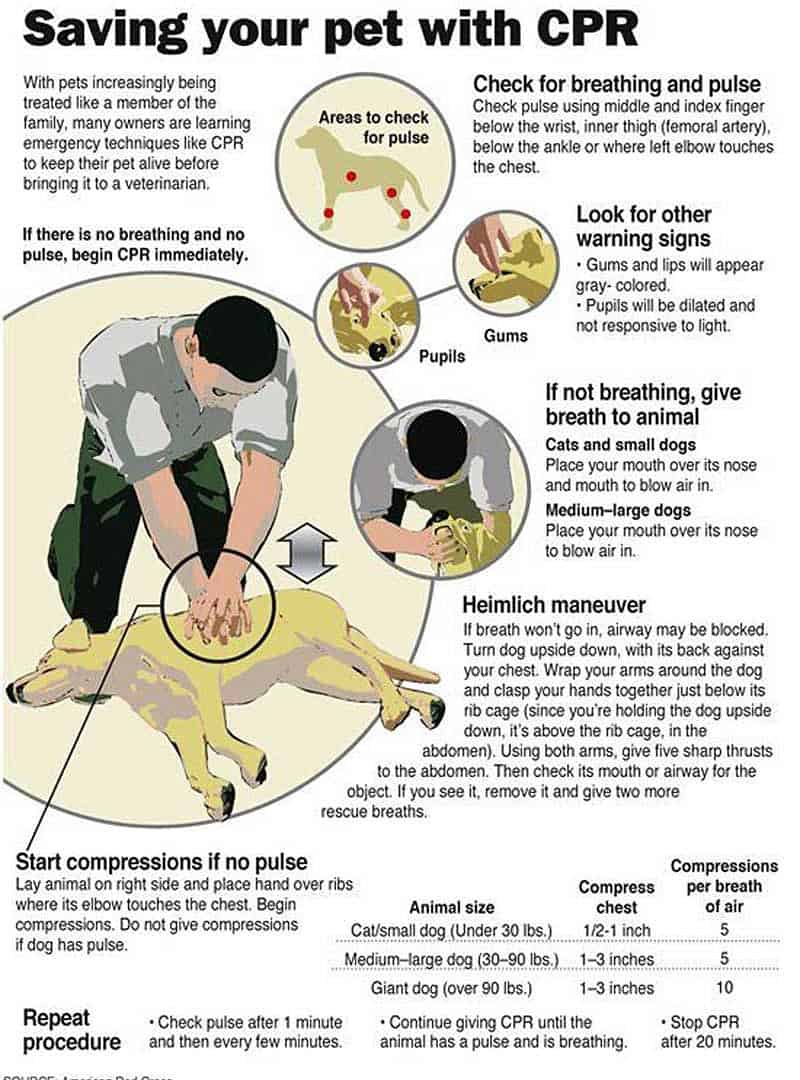Basic Canine Dog & Cat First Aid & CPR
important Dog First Aid and Medical Information for your Pet Dogs and Cats
Basic First Aid Plus Diagram of How to Give Dogs CPR
Traffic Accidents: A traffic accident is probably the most common cause of serious injury to a cat or dog. Always approach the animal with caution, it may react aggressively because of the pain. Move the dog as little as possible, but if you must move it, it is probably best to use a blanket, sliding it underneath the dog.
Seek the assistance of another person and lift the dog gently to safety. Check for a heartbeat and any haemorrhaging. Attempt to stem excessive bleeding by holding a clean pad or clean handkerchief over the wound, binding it tightly with a makeshift bandage. Call the nearest vet’s surgery to warn of your arrival.
Burns: The only recommended first aid is to clean off the affected area and immerse the body part under cold running water for as long as possible. Seek professional advice immediately.
Heat Stroke: This occurs most commonly when a dog has been left alone on a hot day without ventilation. It is also common when exercising on hot days. Very young and older dogs are at higher risk of heat stroke. Brachycephalic breeds (short noses), such as Pugs, Bulldogs, and Boston Terriers are at the most serious risks. Obese, long-haired, and dark-coloured dogs are also at a higher risk, along with dogs with hyperthyroidism, cardiopulmonary disease, laryngeal paralysis, or thick hair coats. Yes, we can trim them. but not too short or the dog can get sunburn and the coat grows again very quickly
If your dog has not already collapsed it may be panting, vomiting or frothing at the mouth. Get your dog out of the heat or in shade Bring down the temperature with water all over the body, not really cold water out of the fridge, normal temperature and slightly tepid for really small dogs, Do not give the dog lots of water to drink if the dog has already collapsed as the kidneys may not be working properly. If it is unconscious do not allow any water into the nose or mouth as this can go directly to the lungs Take the dog to the vet immediately where it will be treated with drugs and more cold water. Read my article for more information (1) Dogs and Hot Weather
Poisoning: Signs of poisoning may include collapse, muscular twitching, vomiting, bleeding or convulsion. Do not hesitate to contact the vet. Take some of the noxious substance to the vet with you if you know what it is. If the dog has recently swallowed the poison, try to make it vomit. methods are a mixture of hydrogen peroxide and water. Mix the regular Chemist strength of hydrogen peroxide (3%) with an equal part of water, but do not attempt to pour it down your dog’s throat, as that could cause inhalation pneumonia. Instead, use a feeding syringe squirt it into the back of the throat I always have a couple in my do first aid equipment along with the Hydrogen Peroxide.
Use a tablespoon of the mixture for every ten pounds of your dog’s weight with a maximum of three tablespoons full for dogs over 45 lbs. Be careful not to let your dog inhale the peroxide, as this can lead to aspiration. you can give him a second dose If your dog doesn’t vomit within 15 minutes, .Once the mixture has been given, he will begin to vomit in about two minutes. When his stomach has settled, give him a teaspoon of Epsom salts in a little water, as this will empty the intestines quickly. The hydrogen peroxide, on ingestion, becomes oxygen and water and is harmless to your dog; it is one of the best antidotes for phosphorus, which is often used in rat poisons. After you have administered this treatment to your pet and his stomach and bowels have been emptied, rush him to your veterinarian for further care.
Don’t make your dog throw up if he exhibits any of the following symptoms or conditions:
- Severely lethargic.
- Already vomiting
- Unconcious.
- Difficulty breathing.
- Seizures or hyperactive.
- Recent abdominal surgery or an enlargement of the oesophagus.
- Consumed corrosive agents, sharp objects, or drugs
Drowning: It is a popular misconception that all dogs can swim, but this is not always the case. You must attempt to empty the dog’s lungs of water as soon as possible. Place the dog’s head lower than its body, open its mouth and begin to pump the chest by pressing down on the ribs and releasing the pressure immediately. Repeat at five-second intervals.
Choking: Sometimes a piece of stick, bone or small rubber ball may get stuck in a dog’s throat. Your dog may be unable to breathe as a result and swift action is necessary. Open the dog’s mouth carefully and see if you can see the object. Pumping the chest, as in the case of drowning (see above) may dislodge the foreign body, get your dog to the vet as soon as possible where the object can be removed under anaesthetic.
COURTESY Collins Dog Photo-guide
How to Give CPR to a Dog

Yet another dog has died recently. That is the 3rd I know of locally already this year and many others have had horrific injuries.
What generally happens is the dog is running with the stick and because of distractions, it turns its head and then back, the stick digs into the ground and is propelled down the throat or up through the soft palate and into the brain.
A lady has just contacted me for behavioural therapy because a bamboo cane splintered in her puppy’s throat after numerous operations the Puppy is now fearful and anxious about handling and is showing initial signs of aggression because of the trauma.
On top of that when chewing sticks they can inhale the small fibres, this can cause lung problems. Once you start your dog with sticks Mother Nature takes over and scatters them everywhere. Therefore the key is to ignore dogs and puppies with sticks and stimulate them with something else like a frisbee, ball, or special retriever dummies.
© Stan Rawlinson 2012 updated regularly
last updated January 2019







